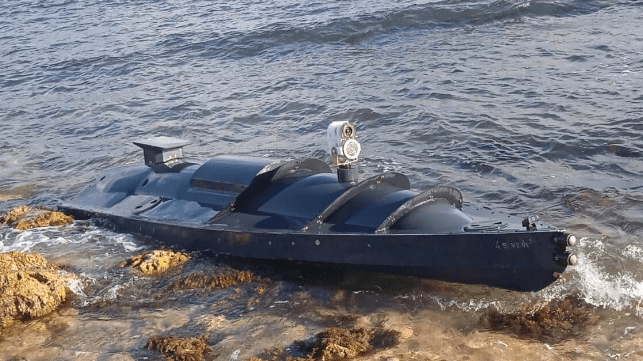Op-Ed: Ukraine's Drone Raid Was Innovative, But Not a Naval Revolution

[By Alessio Patalano]
Last week the naval war in Ukraine came back to international attention. In a theater first defined by the Russian assault against Snake Island in the early stages of the invasion and then by Ukraine’s sinking of the cruiser Moskva, Russian sources reported a new blow. This time, Ukrainian surface and air drones conducted a daring raid on the Crimean port of Sevastopol where Russia’s Black Sea Fleet is based.
Authorities in Moscow claim that the uncrewed capabilities involved in the attack were all neutralized, though they also admitted minor damage to a minesweeper and to harbor defenses. With limited information available on overall battle damage, unlike in the Moskva’s case, the extent of the Ukrainian success this time remains unclear.
Nonetheless, unverified video footage of the events suggests that the attack was much more consequential than Russia claims. Images show uncrewed surface vessels reaching their targets, including the Black Sea Fleet’s flagship since the Moskva was sunk, the frigate Admiral Makarov. Images on Russian social media in the aftermath of the raid show the frigate damaged at sea. If confirmed, this would indeed be a significant result.
The attack was conducted solely by drones, which in turn prompted analysts to speak of a revolution and ‘a new age’ in naval warfare. In a technological triumph of David versus Goliath, small and affordable Ukrainian drones would seemingly be able to destabilize the more powerful and capable Russian fleet. Is this really the case? Do recent events allow us to infer that technology is yet again changing the character of naval warfare?
One should resist the temptation of conflating the revolutionary character of what drones may or may not have achieved. Tactically, Ukrainian maritime exploits were inventive and innovative. Operationally, they were audacious. However, they did not amount to a revolution. Crucially, this technologist focus obfuscates the more important observation that events as we know them may actually indicate a shift in the Ukrainian operational approach to the maritime theater.
Uncrewed surface vessels to strike a fleet, whether at sea or in the safety of a naval base or a sheltering inlet, are a long-established choice in naval warfare. They conceptually draw upon the use of fire ships from the age of sail. These were small, uncrewed vessels packed with explosives—or fire—which were released against surface combatants to damage, disable or, in the most successful case, sink them.
The Ukrainian uncrewed surface vessels in this raid add a contemporary expression to the tradition of the fire ships of ages past. They are innovative solutions to an established practice. Indeed, they speak to the Ukrainian forces’ increasing proficiency in integrating affordable, off-the-shelf military- and non-military-grade technology to exploit asymmetry in capabilities with Russia to maximum effect. If anything, these vessels are a powerful reminder of the crucial primacy of the people behind any piece of technology in imagining its military applications.
This leads to the real operational significance of the Sevastopol raid. Ukrainian forces conducted an offensive operation, striking at the heart of where the Black Sea Fleet felt the safest, its main base. This audacious move, if it weren’t an isolated event, would indicate a shift to assertive operations in line with the wider Ukrainian push to regain control of lost territories, including Crimea.
Previously, notably in the case of the sinking of the Moskva, Ukrainian forces could only deny their opponent freedom of movement across the Black Sea. Now, they are seemingly ready to actively seek out the enemy at a place of their choosing. Such a shift will come at increasing potential costs, with Ukrainian vessels such as tugboats, which are believed to have been involved in deploying drones, likely to become Russian targets.
This naturally leads to another conclusion. Technology does affect the conduct of operations, but sound strategy is crucial to make the most of its effectiveness, especially when one party possesses fewer capabilities. This latest Ukrainian success—once fully appraised—does not undermine or invalidate the value that modern and advanced capabilities possess in shaping a maritime theater.
Indeed, the Russian Navy in the Black Sea is today less safe and secure, but it still retains a capacity to influence the dynamics in this theater. The naval war in the Black Sea is far from over, and it might be punctuated by more frequent attacks on both sides. Russia’s superiority in this theater, though, is especially important because of its capacity to influence the unimpeded shipping of grain, and the use of ports and ships under Ukrainian control.
Thus, as tempting as the quest for silver technological bullets to argue for revolutions in naval warfare is, it is all but premature to claim at this stage that this raid was such a new occurrence. Several pieces of the operational puzzle are missing. The lack of evidence about Russian passive and active measures to defend against drones are of particular relevance, especially since images of similar uncrewed vessels washing up in the vicinity of Sevastopol circulated already in September.
It would appear, instead, that the Clausewitzian trinity of skill, luck and audacity delivered a blow—a mix hardly unheard of in naval history. Months from now, the raid on Sevastopol might very well be remembered for what it told us about where Ukraine was aiming to go operationally, rather than where technology leads naval warfare.
Alessio Patalano is professor of war and strategy in East Asia at King’s College London. This article appears courtesy of The Strategist and may be found in its original form here.
The opinions expressed herein are the author's and not necessarily those of The Maritime Executive.
